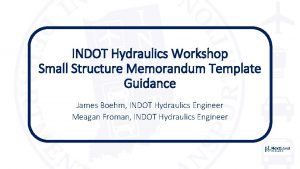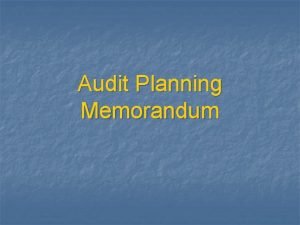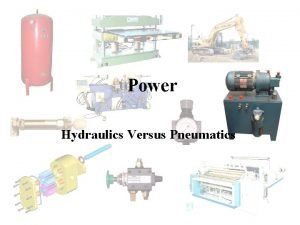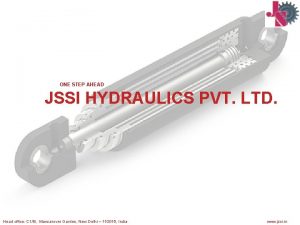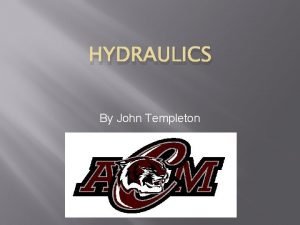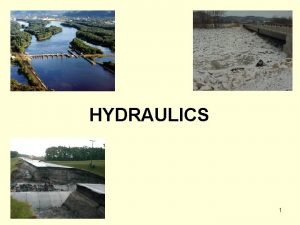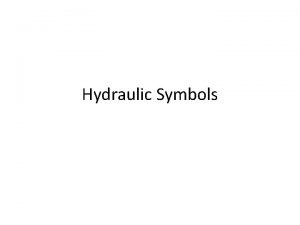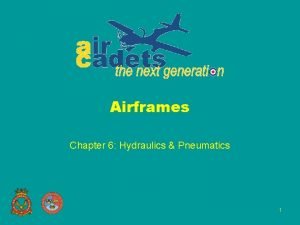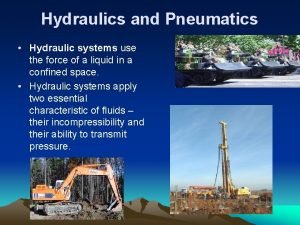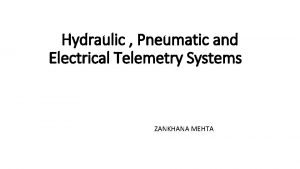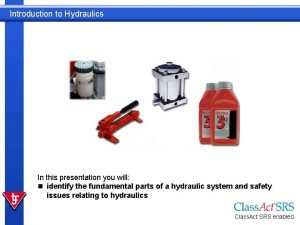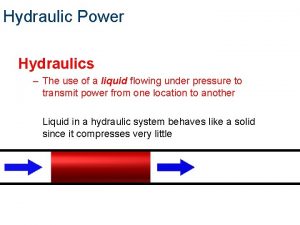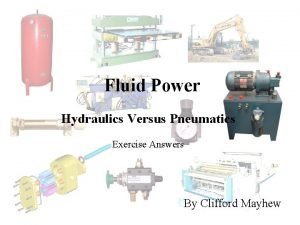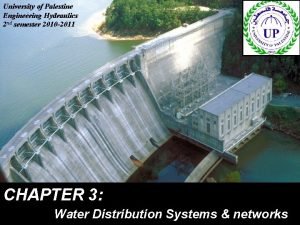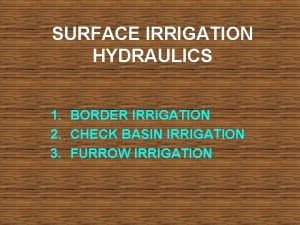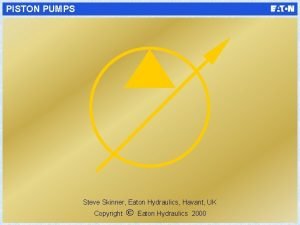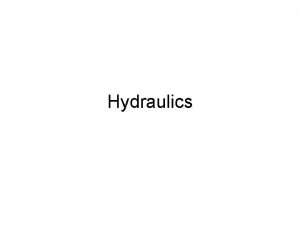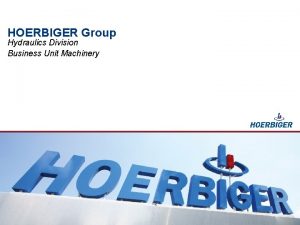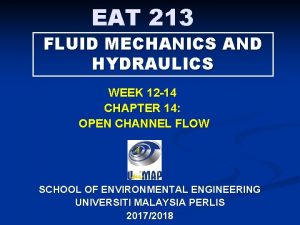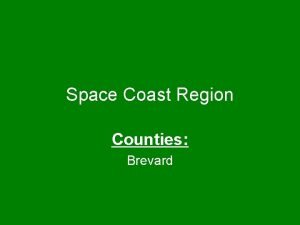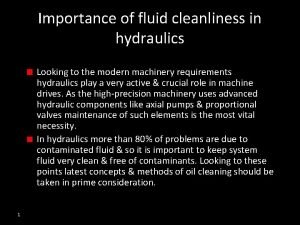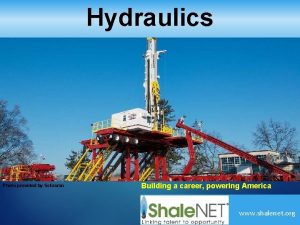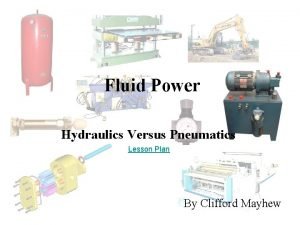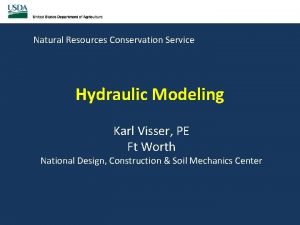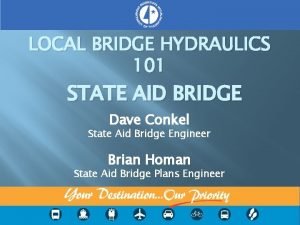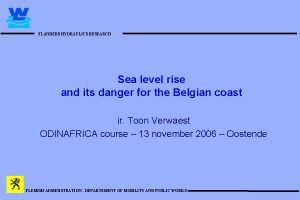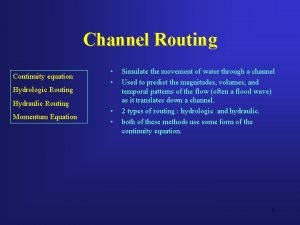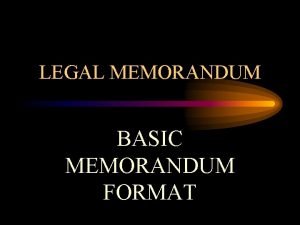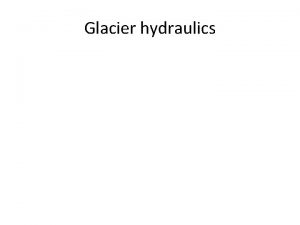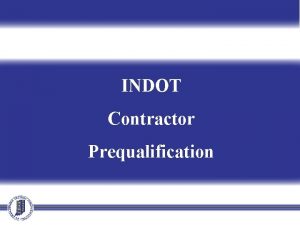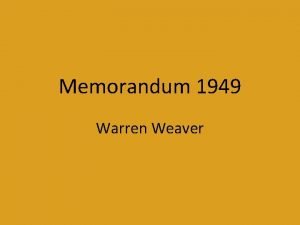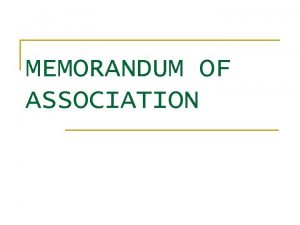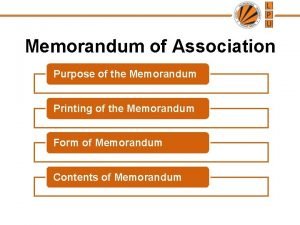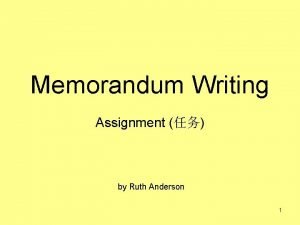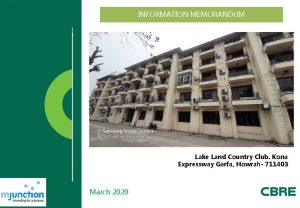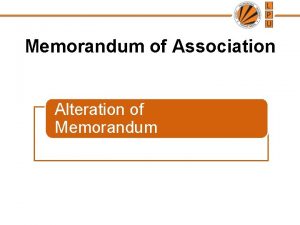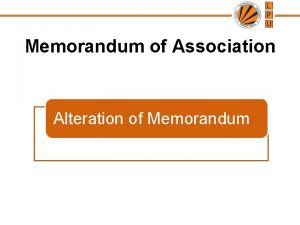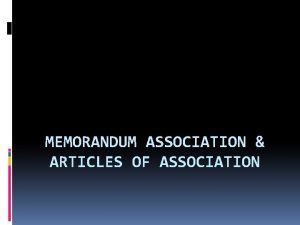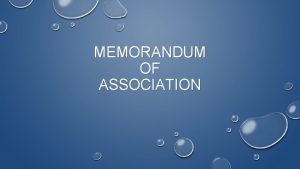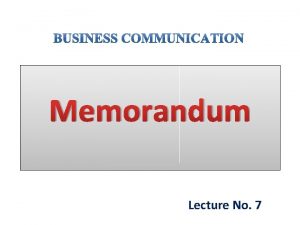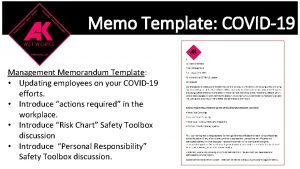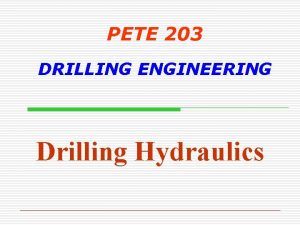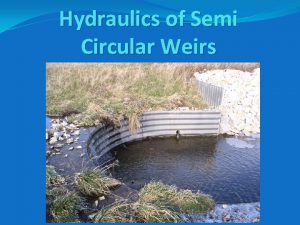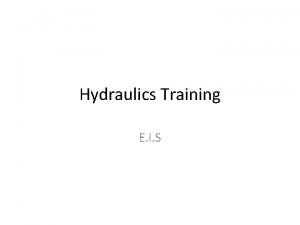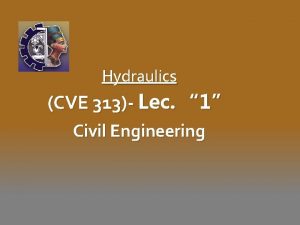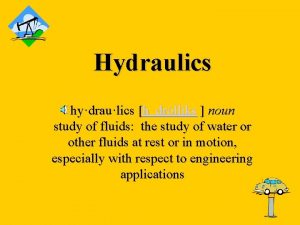INDOT Hydraulics Workshop Small Structure Memorandum Template Guidance



































- Slides: 35

INDOT Hydraulics Workshop Small Structure Memorandum Template Guidance James Boehm, INDOT Hydraulics Engineer Meagan Froman, INDOT Hydraulics Engineer

Overview • New small structure memorandum template • Subject section • Site parameters table • Culvert properties table • Memo body • Riprap design • External energy dissipator • Inlet depressions • Beveled headwall detail • Contact information

New Memorandum Template Why the new template? • Bring better uniformity to the submitted hydraulic memos • Reduce the amount of errors in the submitted hydraulic memos • Remove uncertainty of what is needed in the hydraulic memos INDOT Small Structures Memorandum Template

Dropdown Selection Boxes The greyed out “Choose an item. ” indicates a dropdown selection box. • Click on the greyed “Choose an item. ” • Click on the dropdown arrow, and select the correct item. Not all greyed words are dropdowns (only “Choose an item. ”)

Hover Instructions Hover the curser over certain items. • • Instruction or guidance may appear. Comments are intended to be a FAQ guide only. There is nothing that indicates where they are in the document. Refer to the instruction document if no hover comment is present for an item.

Subject Section • “No Des. ” and “N/A” both acceptable when there is no des. number. • Drop downs for Construction in a Floodway (CIF) Permit and Legal Drain • The memo must be stamped before submittal.

Site Parameters • Design year storm • Tailwater depth vs. outlet depth • Edge of travel lane (ETL) vs. roadway serviceability elevation (RSE)

Site Parameters – Design Year Storm

Site Parameters – Tailwater Depth vs. Outlet Depth

Site Parameters – ETL vs. RSE

Site Parameters – ETL vs. RSE

Question #1 True or false? Better uniformity and eliminating uncertainty of needed data in the hydraulic memorandum are the main reasons for the new memorandum template. Answer: True

Question #2 True or false? If you are unsure of whether to use the tailwater depth or outlet depth in the calculations, use the outlet depth. Answer: False If you are unsure, use the tailwater depth. If the reviewer feels the outlet depth is more appropriate, he/she will notify the designer.

Culvert Properties Table • The table is a snapshot of most important parameters. • If Qdesign is Q 100, remove the second headwater elevation line. • Remove any proposal column that is not used. • Use the dropdowns to select the respective parameter or item. Parameter Culvert Properties Existing Proposal 1 Structure Size & Type Q 100 Headwater Elevation Q Choose an item. Headwater Elevation Meets Roadway Serviceability @ Q Choose an item. Backwater Minimal Low Structure Elevation (DS) Assumed Flowline Elevation (DS) Sump Depth ft. Choose an item. ft. ft. in. ft. Proposal 2 Proposal 3 (delete column if not needed) ft. Choose an item. ft. ft. ft. in. ft. Choose an item. ft. ft. in.

Data Needed From HY 8 • Q 100 headwater elevation • Qdesign headwater elevation • Q 100 tailwater depth • Q 100 outlet depth (if needed) • Outlet invert elevation/assumed flowline elevation HY 8 Culvert Hydraulic Analysis program v 7. 2

Calculating Backwater – Method 1 Existing backwater calculation backwater depth = control depth – tailwater depth

Calculating Backwater – Method 2 Existing backwater calculation backwater depth = Q 100 HW elev. – (US inv. elev. + Q 100 TW depth)

Calculating Backwater – Proposed backwater calculation backwater depthprop = backwater depthex + (Q 100 HW elev. prop – Q 100 HW elev. ex)

Minimal Low Structure Elevation • It is not necessary to specify the rise for three sided or slab top culverts. • The minimal low structure elevation(s) should be included for all replacement proposals. • MLSE = DS flowline elev. – sump depth + rise (at the center of the culvert outlet)

Sumping Requirements • Pipe and box sumping requirements IDM Figure 203 2 E • Replacement structures that convey Waters of the State & Waters of the US should be sumped. • Sumping is no longer required for three sided culverts.

Question #3 The backwater calculation below should be used when? backwater depthprop = backwater depth ex + (Q 100 HW elev. prop – Q 100 HW elev. ex) A) B) C) D) Never For culverts being lined When the culvert inverts of the proposed are different from the existing Answers B and C Answer: D

Question #4 True or false? Three sided structures should be sumped a minimum of 12 inches below the flowline? Answer: False Three-sided structures are not required to be sumped at all.

Memorandum Body/Narrative • Briefly discuss existing conditions • • Existing size location Regulated drain Channel conditions • Discuss pertinent analysis • • • Method for obtaining discharge (Rational, Unit hydrograph, IDNR, etc. ) Tailwater method (channel, constant, or zero tailwater depth) Joint probability (if used) Design storm frequency (IDM Figure 203 2 C) requirements Modeling method or software used • Discuss special conditions or requirements • • Special inlet configuration (headwall required, or inlet depression) Sumping requirements Grade changes Change in invert elevations

Riprap Design

Riprap Design – Outlet and Tailwater Velocities

External Energy Dissipator

External Energy Dissipator

Inlet Depression HDS 5 – Figure 3. 5 Culvert with Inlet Depression Properties Table Parameter Replacement Option T D B D/2 (apron) B + 4 T (total width) D/2 + 2 T (total length) Total Crest Width Riprap Class Inlet Depression Properties Option #1 Option #2 Option #3 User Def Rise Span Calc 1 ft ft ft Calc 2 ft ft ft Calc 3 ft ft ft Calc 2 + 2(Calc 3) ft ft ft Choose an item. Option #4 ft ft Choose an item. Include both the figure and completed table in the memorandum if proposing an inlet depression. Otherwise delete it.

Inlet Depression Inputs – HY 8 • Select “yes” for “Inlet Depression? ” • Type in the depression depth. • Type in the fall slope (2: 1 3: 1). • Type in the crest width (total crest width from the table). • The inlet invert elevation should be the intended invert plus the height of the depression. HY 8 Culvert Hydraulic Analysis program v 7. 2

Beveled Edge Headwall Detail • Include the detail and source whenever a beveled edge headwall is proposed. • The included detail is for a 1: 1 bevel. • The figure is not required for a square edge headwall. Source: J. D. Schall, Hydraulic design of highway culverts, 3 rd ed. Washington, D. C. : U. S. Dept. of Transportation, Federal Highway Administration, 2012. Pg. 3. 5, Fig. 3. 3

Question #5 At what outlet velocity is an energy dissipator required? A) B) C) D) Velocity ≥ 10 ft/s Velocity > 10 ft/s Velocity ≥ 13 ft/s Velocity > 13 ft/s Answer: D

Question #6 What structures require inlet riprap based on shape alone? A) B) C) D) Only three sided structures Three sided structures and boxes Three sided structures and structures with a span ≥ 8 feet. None Answer: B

Question #7 When designing an inlet depression using HY 8 the intended fall slope must be? A) B) C) D) Any slope ratio the designer desires Equal to or between 2: 1 and 3: 1 Equal to or between 3: 1 and 4: 1 Equal to or between 1: 1 and 3: 1 Answer: B

Contact Information

Thank You Access the new memo template and instructions on the hydraulics website. https: //www. in. gov/indot/3595. htm
 Indot hydraulics
Indot hydraulics Compensating curve denture
Compensating curve denture Direct guidance
Direct guidance Conceptualisatio
Conceptualisatio Career guidance presentation
Career guidance presentation Proposal writing on career guidance workshop
Proposal writing on career guidance workshop Memorandum
Memorandum Hydraulics vs pneumatics
Hydraulics vs pneumatics Jssi hydraulics pvt. ltd
Jssi hydraulics pvt. ltd Hydraulics definition
Hydraulics definition Hydraulics definition
Hydraulics definition Unidirectional variable displacement pump symbol
Unidirectional variable displacement pump symbol Hydraulics and pneumatics
Hydraulics and pneumatics Hydraulics & pneumatics
Hydraulics & pneumatics Hydraulics and pneumatics
Hydraulics and pneumatics Mehta hydraulics
Mehta hydraulics Hydraulic presentation
Hydraulic presentation Hydraulics
Hydraulics Hydraulics and pneumatics quiz
Hydraulics and pneumatics quiz Palestine hydraulics
Palestine hydraulics Check basin irrigation advantages and disadvantages
Check basin irrigation advantages and disadvantages Eaton havant
Eaton havant Hydraulics
Hydraulics Press brake hydraulic diagram
Press brake hydraulic diagram Hydraulics
Hydraulics Space coast hydraulics
Space coast hydraulics Fluid cleanliness system
Fluid cleanliness system Professional hydraulics
Professional hydraulics Give the standard graphical symbols for frl unit
Give the standard graphical symbols for frl unit Karl visser
Karl visser Hydraulics 101
Hydraulics 101 Khan academy hydraulics
Khan academy hydraulics Toon verwaest
Toon verwaest Hydrologic continuity equation
Hydrologic continuity equation Hydraulic routing methods
Hydraulic routing methods Public agency training
Public agency training
